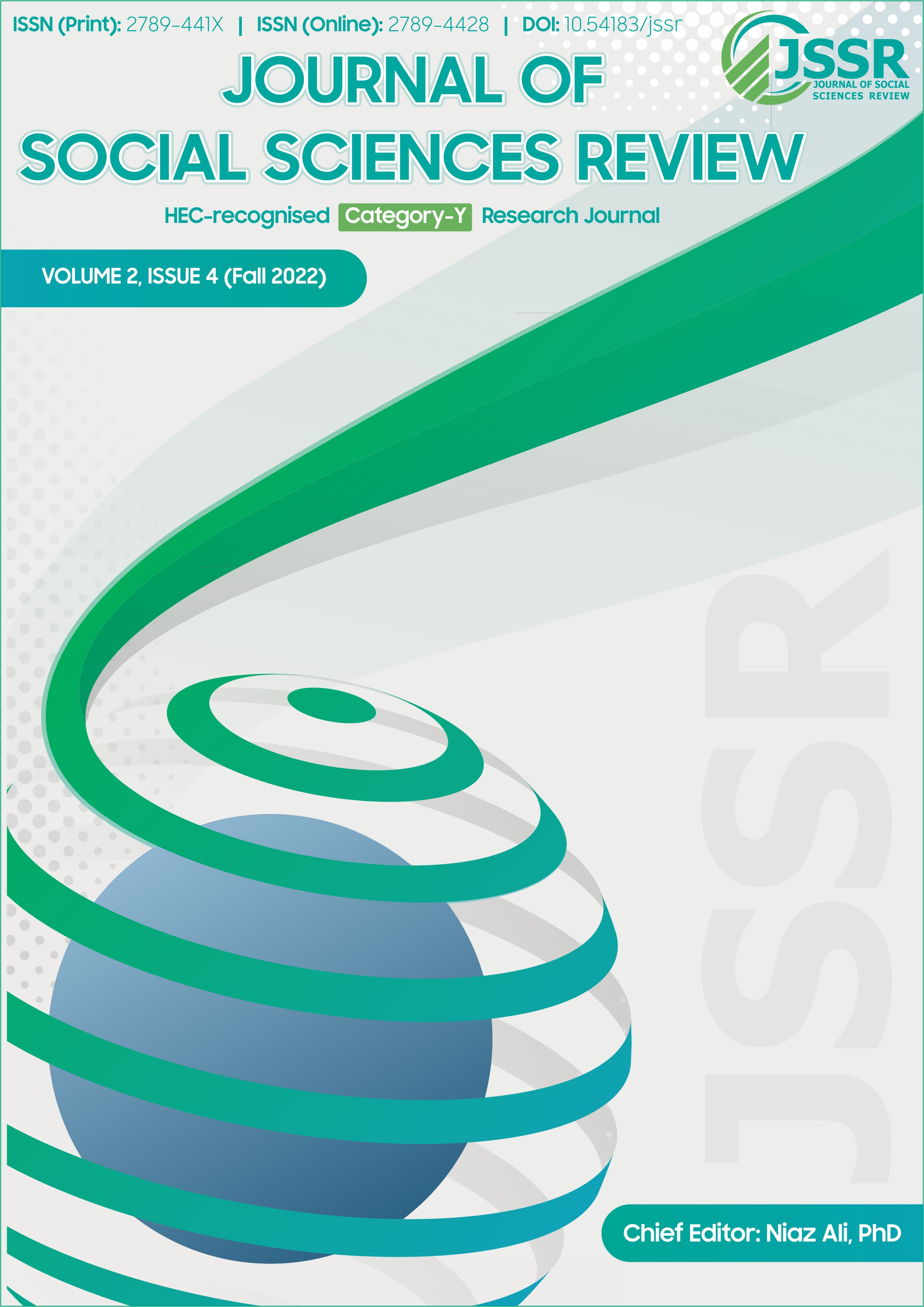A Review of China-Kazakhstan Economic Relationship during the 21st Century
DOI:
https://doi.org/10.54183/jssr.v2i4.56Keywords:
China-Kazakhstan Energy Relationship, Belt & Road Initiative, Central Asian Republics, Economic DiplomacyAbstract
Economic diplomacy promotes a state's national interest through economic apparatuses. China has efficiently applied this craft in Central Asia and other parts of the world through infrastructure development projects which in turn would make China better off in energy, economy and security. The Central Asian Republic of Kazakhstan is the largest land-locked country in the world which shares a long border with China. This former Soviet Republic has pivotal strategic potential due to its location and massive natural reserves. Since China's energy needs are ever-increasing because of its enormous industrial capacity so she is preferably considering Kazakhstan for energy partnership. Two out of six economic corridors of "Belt & Road Initiative" (BRI) of China are also passing through Kazakh Republic. These considerations make Kazakhstan specifically and Central Asia generally a centre of China's attention. In that perspective, the instant study investigates China's economic policy towards Kazakhstan. A qualitative method of reasoning is followed to find the results. It reveals that Kazakhstan has obtained a central role in fulfilling the energy requirements of China.
References
Daojiong, Z. (2015). China’s economic diplomacy: Focusing on the Asia-Pacific region. China Quarterly of International Strategic Studies, 1(1), 85–104. https://doi.org/10.1142/S2377740015500050
Kazakhstan -Turkmenistan - Iran railway is of strategic importance for Silk Road revival. (n.d.). Информационное Агентство Кабар. http://en.kabar.kg/news/kazakhstan-turkmenistan-iran-railway-is-of-strategic-importance-for-silk-road-revival/
Khissimova, D. (2021, Aug 11). Cargo Traffic of KTZE-Khorgos Gateway Dry Port on Kazakh-Chinese Border Continues Operation Despite Pandemic. The Astana Times: https://astanatimes.com/2021/08/cargo-traffic-of-ktze-khorgos-gateway-dry-port-on-kazakh-chinese-border-continues-operation-despite-pandemic
Kumenov, A. (2022, Aug 24). Kazakhstan: Specter of Chinese control over oil and gas largely illusory. Eurasianet: https://eurasianet.org/kazakhstan-specter-of-chinese-control-over-oil-and-gas-largely-illusory
Laruelle, M., George Washington University. Central Asia Program., & Nazarbayev University. (n.d.). China’s Belt and Road Initiative and its impact in Central Asia.
Lee, E. (2018). The Belt and Road Initiative: Impact on Trade Patterns Between China and Central Asia. East Asian Community Review, 1(3–4), 185–198. https://doi.org/10.1057/s42215-019-00015-3
Xuanli Liao, J. (2019). China’s energy diplomacy towards Central Asia and the implications on its “belt and road initiative.” The Pacific Review, 34(3), 490–522. https://doi.org/10.1080/09512748.2019.1705882
Nabiyeva, K. (2019, April). Win-win or Win-lose? China-Kazakhstan Energy Cooperation within the Belt and Road Initiative. Blickwechsel.
Peyrouse, S. (2008). Chinese Economic Presence in Kazakhstan. China Perspectives, 2008(3), 34–49. https://doi.org/10.4000/chinaperspectives.4053
Pieper, M. (2020). The linchpin of Eurasia: Kazakhstan and the Eurasian economic union between Russia’s defensive regionalism and China’s new Silk Roads. International Politics, 58, 462-482. https://doi.org/10.1057/s41311-020-00244-6
Pradhan, R., & Mohanty, S. S. (2021). Chinese Grand Strategies in Central Asia: The Role of Shanghai Cooperation Organization and Belt and Road Initiative. Fudan Journal of the Humanities and Social Sciences, 14(2), 197–223. https://doi.org/10.1007/s40647-021-00318-6
Qi, R. (2017, June 6). Energy ties further boosted in Central Asia - Business - Chinadaily.com.cn. ChinaDaily.com.cn. https://www.chinadaily.com.cn/business/2017-06/09/content_29678580.htm
Rozanov, A. A. (Ed.). (2013). The Shanghai Cooperation Organisation and Central Asia’s Security Challenges. Geneva: Procon Ltd.
Sacks, D. (2021, March 24). Countries in China’s Belt and Road Initiative: Who’s In And Who’s Out. Council on Foreign Relations: https://www.cfr.org/blog/countries-chinas-belt-and-road-initiative-whos-and-whos-out
Sagsen, İ., & Turan, İ. (2021, Dec). THE ROLE OF KAZAKHSTAN IN THE ENERGY SECURITY OF CHINA. The International Journal of Economic and Social Research, 17(02).
Toman, M. (2019). China's global influence in 2025: Projected foreign policy strategies.
Uranium and Nuclear Power in Kazakhstan. (2022, June). World Nuclear Association: https://world-nuclear.org/information-library/country-profiles/countries-g-n/kazakhstan.aspx
Usman, S. M. (2019, July-Sep). China role and interest in Kazakhstan. THINK INDIA (Quarterly Journal), 22(3), 417-431.
World Bank. (2020, June). South Caucasus and Central Asia: The Belt and Road Initiative Kazakhstan Country Case Study. https://openknowledge.worldbank.org/bitstream/handle/10986/34117/South-Caucasus-and-Central-Asia-The-Belt-and-Road-Initiative-Kazakhstan-Country-Case-Study.pdf?sequence=4&isAllowed=y
Zogg, B. (2019, September). Kazakhstan: A Centrepiece in China’s Belt and Road. (E. Z. Center for Security Studies (CSS), Ed.)
Downloads
Published
Issue
Section
License
Copyright (c) 2023 Copyright in the Journal of Social Sciences Review is retained by the author(s). Authors also grant any third party the right to use the article freely as long as its integrity is maintained and its original authors, citation details and publisher are identified.

This work is licensed under a Creative Commons Attribution-NonCommercial 4.0 International License.
SSR's Editorial Board shares the vision of providing free access to information, education, and science for everyone, thus promoting its content through an OPEN ACCESS POLICY, fulfilling the DOAJ definition of open access. The JSSR adheres to an Open Access and Copyright Licensing Policy based on the belief that making research freely accessible to the public promotes greater global knowledge sharing.
The JSSR uses the Creative Commons Attribution-NonCommercial 4.0 International License. The authors who apply and publish in JSSR consent to abide by the copyright policy set out in the Creative Commons 4.0 license (Attribution-NonCommercial 4.0 International license).
- Copyright in the Journal of Social Sciences Review is retained by the author(s).
- Authors also grant any third party the right to use the article freely as long as its integrity is maintained and its original authors, citation details and publisher are identified.
While "By 'open access' to this literature, we mean its free availability on the public internet, permitting any users to read, download, copy, distribute, print, search, or link to the full texts of these articles, crawl them for indexing, pass them as data to software, or use them for any other lawful purpose, without financial, legal, or technical barriers other than those inseparable from gaining access to the internet itself."



